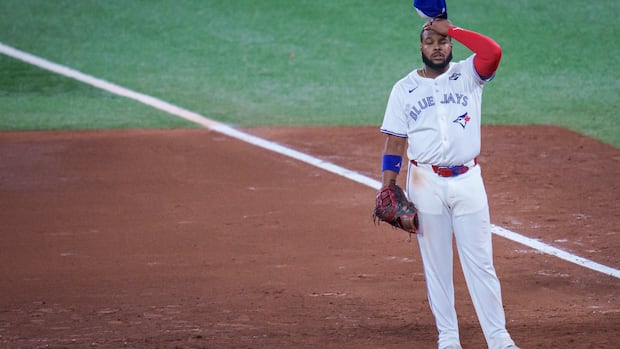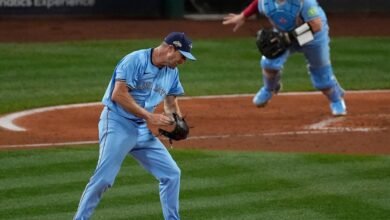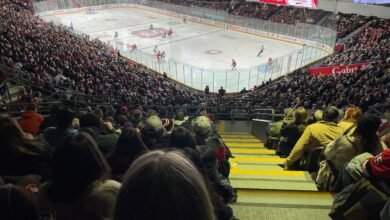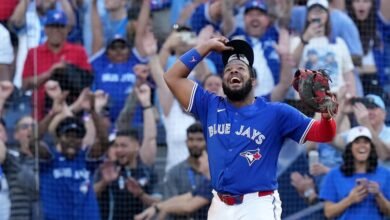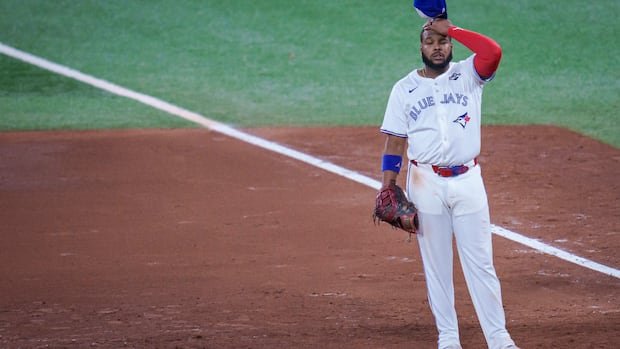
Fourteen years, $500 million US, one player and one telecom giant all add up to increased revenue for Rogers Communications as its Toronto Blue Jays play in the World Series.
After signing his blockbuster, 14-year deal back in April, first baseman Vladimir Guerrero Jr. has been considered by many sports analysts as a key element of the team making it to the World Series.
And some economists who focus on sports say, even at half a billion dollars, the seemingly massive cost to keep the superstar Montreal native on the team pays off from a business perspective.
“If you make it all the way to the World Series and it’s that one big signing like Vlad that makes it there, it probably is [worth it],” said Victor Matheson professor of economics at the College of the Holy Cross in Worcester, Mass.
Matheson says, with just ticket sales to the World Series games alone, Rogers may have made back what it has paid Guerrero so far.
That’s based on his prediction of extra ticket revenue — based on what other teams have made in the past — even after subtracting the money the team must split with the players and the league.
“In terms of just this year, just the ticket sales gets you a full payment of this player’s salary, so that’s pretty good. And of course that’s just part of the money, right?”
A blockbuster deal to lock in Vladimir Guerrero Jr. this past spring may be leading to financial windfalls for Toronto Blue Jays’ owner Rogers Communications.
Indeed, there are many other parts of the money for Rogers.
Rogers owns the team itself, along with the stadium — formerly known as SkyDome and now Rogers Centre. So it doesn’t just make money from the Jays but from food, drink and merchandise sold at the stadium.
It owns the television network that broadcasts the bulk of the Jays games in Canada — Sportsnet — and one of the major cable systems many Canadians use to buy that channel, Rogers Cable.

Notably, the company said media and sports revenue was up 26 per cent in its most recent quarterly earnings, compared to wireless service revenue described as “flat” and cable revenue which grew only one per cent.
The company has said it wants to make the Blue Jays, along with its control of Maple Leaf Sports and Entertainment (MLSE), into one of the “best sports businesses” globally.
“This is our third pillar of growth beyond wireless and cable,” said Rogers CEO Tony Staffieri.
Rogers is also predicting there is even more money to come due to its team making the baseball post-season.
“The Blue Jays’ very successful MLB playoffs and World Series run will provide further added growth in the fourth quarter,” said Rogers chief financial officer Glenn Brandt in an earnings call with investors last week.
There’s still risk for Rogers
Despite rosy results in 2025, spending half a billion for the next 14 years on a star player does not guarantee financial success, says Matheson.
He points out that if the Jays have a bad run, Rogers will still be paying for a very expensive first baseman for more than a decade.

(CBC)
“It’s a much bigger risk in a smaller market like Toronto where having a down season, like they did last season, might be the thing that is pretty expensive when you’ve got a $35 million per year player on your roster,” he said.
But major-market teams often need to hire big-name stars to telegraph to audiences that their team and their city is worth the cost of a ticket or merchandise, Matheson says.
That could be part of how a company like Rogers and its shareholders look at Guerrero as an investment, according to economist Duane Rockerbie.
“They’re maximizing shareholder return… they need a marquee player,” said Rockerbie, who researches sports economics at the University of Lethbridge in Alberta.
Rockerbie says having a known superstar will get people interested in the Blue Jays, and that could lead them to purchase other products and services from the Jays or Rogers.
He likens it to a luxury offering at a car showroom. Audiences are attracted to the big-ticket item — and then maybe, they spend their money on something else instead.
“They have a Corvette sitting there … they don’t make a lot of them and they’re really expensive, but it’s their flagship thing. It gets people in there. And then maybe they buy some cheap Chevy truck or something,” he said.
According to Rockerbie, even if Rogers lost money on the half-billion-dollar Guerrero contract, it could make money on all its other operations due to his star power and draw.

‘Spend that money’
From the fan perspective, sports analyst Steve Glynn says he’s just fine with Rogers spending hundreds of millions on a superstar.
“It’s my team, so I don’t care if they just bought their way in … spend that money,” said Glynn, who previously worked for Sportsnet and now operates his own podcast network.
He says it’s Jays fans and Rogers customers who are ultimately paying for the blockbuster deal to retain Guerrero.
“It’s my money anyway, right? Like we’re all paying for the tickets and the beer and the hot dog as long as your forearm,” he said.
Glynn also says, in his opinion, Rogers has previously “set money on fire with a blowtorch” and still managed to succeed.

One thing he says fans should not expect? For Rogers — through MLSE, which also owns Toronto’s NHL team — to also purchase a trip to the Stanley Cup via superstar contracts.
“Hockey has a hard salary cap that doesn’t allow teams to spend above a certain threshold on players … you cannot buy a championship in hockey,” said Glynn.
“That, and the Leafs are cursed.”
Source link
